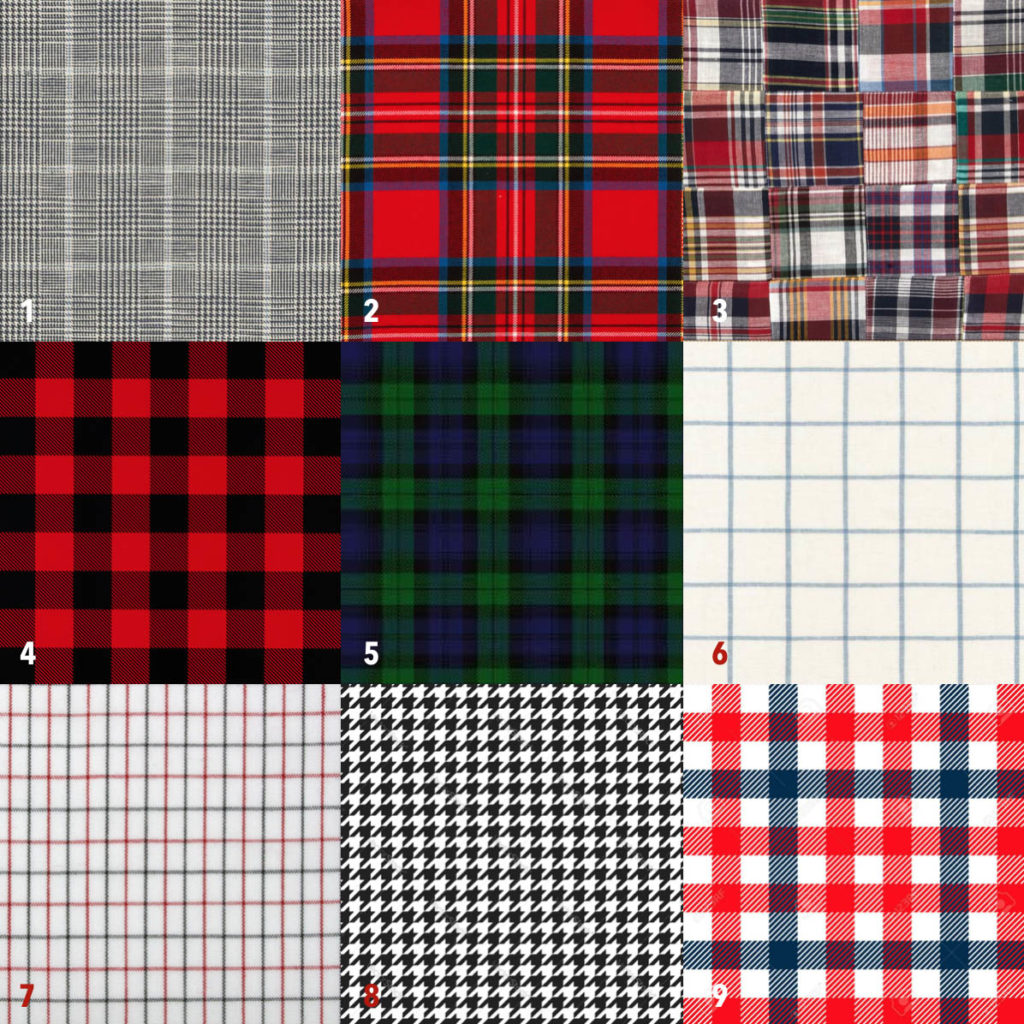First things first. It’s important when we talk of the origin and true construction of plaids, that we speak of them as ‘patterns’, not ‘prints’. A print implies that the fabric is woven, and then a separate printing machine prints the pattern ON TOP of the finished fabric. This contrasts to the construction of a true plaid, where the individual warp (length) and weft (width) yarns are dyed various colors and then woven together to create the finished fabric. While you can buy ‘printed’ plaids, it is important to know that woven plaids are of higher quality and workmanship, and represent an entirely different fabric weaving process than we see in most of the prints highlighted in my Traditional Textile Techniques Design Quiz.

With that said, you think you have what it takes to name all 9 plaid patterns below? Here we go!
Plaids (In no particular order)
Buffalo
Tartan
Tattersall
Glen
Blackwatch
Madras
Gingham
Windowpane
Houndstooth

How do you think you did? Were you able to nail all 9 plaids? Were there any that tripped you up? Here we go with the answers…
>>>>>>>>>>>>>>>>>>>>>>>>>> <<<<<<<<<<<<<<<<<<<<<<<<<<
1. Glen
The term glen plaid comes from the Glenurquhart valley in Scotland, where the textile pattern was first created in the 19th century. It is often called Prince of Wales Check, after the Prince of Wales Sir Edward VIII who loved the small black and white (which looks grey together) pattern for his custom suits. I personally love a Glen plaid for men or women, as you can see me rocking my Glen plaid pants here!
2. Tartan
Unfortunately for you, this one is a bit of a trick. Since plaids originated in Scotland, Tartan is actually the original, all-encompassing synonym for the word Plaid. So everything here in the US we call plaid, they Scots call Tartan, and vise versa. All of the other 8 forms of plaid mentioned in this quiz are versions of Tartans, each designed for different families, characters or occasions. Anyone who has watched SATC knows that Scottish families each have their own Tartan weave, with different colors and size bands. Traditionally these were all woven in wool yarns, and worn as kilts, jackets and wraps for Scottish Highland events.
3. Madras
The unique quality of Madras cloth, is that it is actually several plaids cut up and re-sewn together in a patchwork pattern. The name originates from India, in the town of Madras, which is now known as Chennai. The plaid pattern is the same on both sides of the fabric, and as the original plaids are spun of cotton muslin fibers and made by hand, they often have a slub texture. In modern day, Madras fabrics are seen as warm weather clothing, as it is one of the few plaids made of cotton, which has extreme breathability.
4. Buffalo
The Buffalo plaid (or check as it is commonly called), has a mixed historic background. Some say it was a plaid introduced to the US by a descendant of Rob Roy, while some say it originated from the Woolrich Woolen Mills. The legend here is that the designer of the distinctive deep red and black check used to herd Buffalo, hence the name. Regardless of it’s origin, back when I worked for Gap, it was the single biggest seller in Men’s Woven Tops every winter!
5. Blackwatch
The origin of Blackwatch plaid is very straightforward. It is the plaid pattern of the Black Watch, 3rd Batalion, Royal Regiment of Scotland. These days, there are various versions of different scale, but all have the signature combination of navy blue and hunter green in wide bands of color.
6. Windowpane
There is less information out there about the origin of this particular pattern, but the name says it all. It is identified by the thin stripes of color in relation to the base ‘ground’ color, similar to the a windowpane. Windowpane plaids can come in all color combinations, but are typically seen as black on white, or white on black.
7. Tattersall
The Tattersall pattern is made of regularly-spaced thin, even, repeating warp and weft stripes creating a square or rectangle pattern. It contrasts with the windowpane because of its much smaller scale, and the stripes are usually in two alternating colors, generally darker on a light ground. The cloth pattern takes its name from the Tattersall Horse Market, which started in London in the 18th century. Horse blankets with this pattern were sold at the market then, and now it is an extremely common pattern for menswear shirting.
8. Houndstooth
Although it also originated in Scotland, the houndstooth pattern was so named after it’s resemblance to dogs’ teeth. Houndstooth is always comprised of 2 contrast colors. Most importantly, it’s relevant to know that in contrast to all of the other plaids in today’s quiz, this pattern is woven by a different weave structure altogether. While most plaids have a traditional ‘under-over-under-over’ structure, houndstooth is ‘under-under-over-over’ which creates longer ‘floats’ in the colors, and thus gives the teeth little ‘legs’.
9. Gingham
Definitely the most widely used plaid in apparel and home furnishings, gingham contrasts to the above plaids in that it’s origin is either from France or Denmark, but brought to mass via England. It consists of equal parts color bands to ground bands, resulting in even sized squares, always on a white ground. It originated in navy blue and white, but today can be found in every color way, fabric weight and use, making it equal parts perfect for your summer picnic as your holiday stockings!


